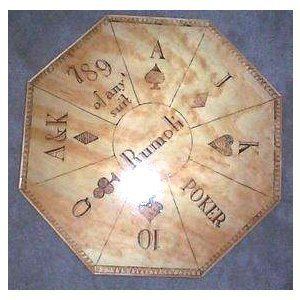 | ||
Rummoli is a family card game for 2 to 8 people. This Canadian board game, first marketed in 1940 by the Copp Clark Publishing Company of Toronto requires a Rummoli board, a deck of playing cards (52 cards, no jokers), and chips or coins to play. The game is usually played for fun, or for small stakes (e.g. Canadian Dimes). Rummoli is similar to Michigan Rummy.
Contents
Rummoli board
A Rummoli board, used during play, has the shape of an octagon. It is generally simply printed on a large sheet of paper.
In the centre of the board is a pot called Rummoli, surrounded by eight pots:
Each of these pots on the board is used to store chips. The ordering of the pots around the board is not important.
Play
Ace is high. For brevity, in the following description the "lowest card" means the lowest card in a player's hand or, if two or more cards are equally low, either or any of them.
A game is played in one or more rounds. The game ends at the end of a round, at the discretion of the players. For example it may be agreed to finish at a certain time, or when all but one player have exhausted their chips.
Rounds
For each round, there are four stages: the Deal, the Poker phase, the Rummoli phase, and the End of round, which are played in sequence. But each round must begin with the 2 of clubs.
Deal
Before the cards are dealt, each player pays one chip to each pot on the Rummoli board. The dealer then deals around the table to every player, and an extra hand (in some terminology known as a ghost hand) called the widow.
Once the bid is accepted the player is committed to the exchange regardless if the widow is a poorer hand. The widow hand takes no further part in the play.
Poker phase
Rummoli phase
While this phase is being played if any player lays down a card corresponding to a pot such as Ace of Spades, the player picks up that pot. If a player places down a card that corresponds to a pot without realizing so, then the chips stay in the pot.
The player with the next card in the sequence of the suit must lay that card, and this continues with players laying cards until nobody has the card that follows in sequence.
A card once laid takes no further part in the play.
End of round
The first player to have an empty hand wins the Rummoli pot.
The deal shifts after each round, one player clockwise.
End of play
After the agreed end of the round play, all chips on the board are placed into one pot and a round of poker dealt and played for it. A variation is to play a round for each pot that still has chips in it, starting with the pot with the fewest chips.
The player with the most chips at the end of the game wins.
